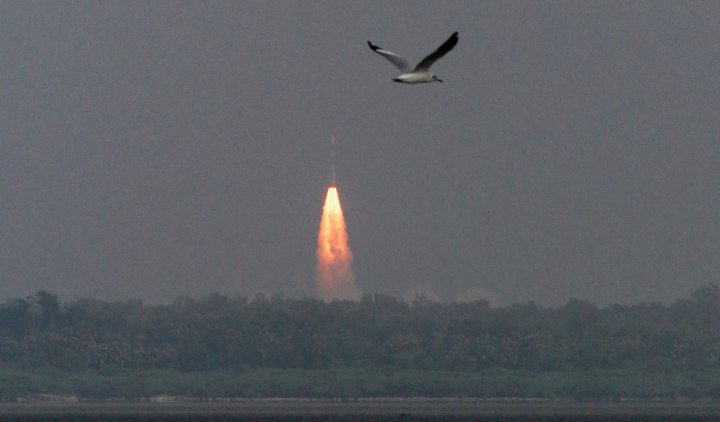World
India joins the space age, with a bang

Interplanetary travel is the preserve of a very small group of nations. On Tuesday, India bid to join this club as it launched a spacecraft bound for Mars. After a flawless blast off, Mangalyaan is on its way to the red planet, 680 million kilometres away, taking India’s space age ambitions with it. By SIMON ALLISON.
At precisely 2:38pm Indian Standard Time, on the south-east Indian island of Sriharikota, four rocket motors containing hundreds of tons of propellant ignited in a controlled, synchronised explosion. The force of the blast lifted an Indian-designed and Indian-built rocket into an orbit around Earth – and with it, a nation’s hopes of joining the interplanetary elite.
This launch is a really big deal for India. On top of the rocket is a capsule, weighing a little over a ton, that India’s scientists are calling the Mars Orbital Mission (MOM). Popularly, it’s known as Mangalyaan, which is Hindi for Mars-craft. Either way, the clue is in the title: this little rocket ship is heading for the red planet. If it gets there, it will have succeeded where plenty others have failed, including Asian rivals China and Japan, becoming only the fourth space agency to achieve the feat (after the Americans, the Soviets and the Europeans).
Even though the launch was a success, it will still be a long time before we know the fate of the mission as a whole. Because India’s rocket technology is not yet powerful enough to send Mangalyaan directly to Mars, it must wait – quite literally – for the planets to align before maneuvering itself onto a trajectory that will take it there.
And once it arrives, the mission is not exactly going to be cutting-edge, either scientifically or technologically. There are other orbital craft already there with bigger payloads and better orbits (Mangalyaan will have an elliptical, uncomfortably long orbit because it won’t have the power to get anything better). Nasa, of course, has rovers on the surface of the planet – a technological achievement still well out of India’s reach.
The Indian craft packs just 15 kilograms of scientific equipment. To put this in perspective, a Nasa craft being sent out later this month (to take advantage of the same planetary alignment) will have a single instrument (one of many) that weighs 27 kilograms. About the best scientists can hope for from the Indian mission is better data to bolster existing theories and some fabulous pictures from a fancy new camera.
Although true, all these limitations are beside the point: India’s mission to Mars is not about competing with the big boys of the space exploration world. It’s about showing what India can do, and laying the framework for further, more complex exploration missions.
“Orbiting Mars itself is a challenge,” said K. Radhakrishnan, chairman of the Indian Space Research Organisation (ISRO), speaking to the Times of India. “This is our first interplanetary mission. There will be bigger missions later.”
It is also designed as a signal to the world about India’s level of technological accomplishment. Undeveloped, third-world countries can’t pull off unmanned flights to another planet; India can. As signals go, it’s a compelling one, presuming the mission is a success.
There’s also the little matter of getting one-up on China in what’s popularly billed as ‘the Asian space race’, although this may be something of a misnomer. Fundamentally, both programs have different goals, making it hard to directly compare their progress. As Emily Lakdawalla, senior editor for the Planetary Society, explains:
“China’s program is a focused and measured one, with human exploration of the Moon as the eventual goal. Their space station program and robotic lunar exploration both represent incremental, measured steps toward that. There’s no race happening because there’s no one competing with them to achieve that goal…[India’s] approach is focused more on economic development. As a rapidly developing country, it is seeking to demonstrate technological capability to the world, presenting them as a place worthy of foreign investment in high-tech industry.”
The mission has received criticism from some quarters, who point out that the millions of dollars sunk into space research might be better spent addressing India’s more immediate problems: poverty, healthcare, education, etc. It’s a valid point, but perhaps a little unfair.
For one thing, the mission’s price tag is a snip at $73 million (just a tenth of what Nasa spends on similar programs, according to the Wall Street Journal). Mangalyaan is the Ryanair or Kulula of space travel. For another, it ignores the general economic benefits that space exploration can bring. For example: G. Scott Hubbard, a former director Nasa’s research institute, estimates that for every dollar spent on the space program, the US economy received $8 of economic benefit. Even if India’s returns are not so spectacular – and they’re unlikely to be, at least in the short term, given that ISRO is not yet on the cutting edge of technological development – any investment put in to space exploration is likely to be recovered.
There’s still a long time to wait until we know however, whether this particular mission is a worthwhile investment. Even with the favourable alignment, Mars is a long, long way away – 680 million kilometers, to be precise – and it will take Mangalyaan the better part of a year to reach its destination. There’s plenty that might go wrong before then. If it all goes right, however, then India will have proved beyond any doubt that it belongs in the space age. DM
Read more:
- India prepares to take flight: FAQs on Planetary Society
- India launches rocket in hope of joining elite Mars explorer club on CNN
Photo: India’s Polar Satellite Launch Vehicle (PSLV-C25), carrying the Mars orbiter, lifts off from the Satish Dhawan Space Centre in Sriharikota, about 100 km (62 miles) north of the southern Indian city of Chennai November 5, 2013. India launched its first rocket to Mars on Tuesday, aiming to put a satellite in orbit around the red planet at a lower cost than previous missions and potentially positioning the emerging Asian nation as a budget player in the global space race. REUTERS/Babu



















